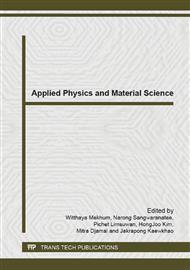[1]
T. Nozaki, K. Hayashi, T. Kajitani, Thermoelectric Properties of Delafossite-Type Oxides CuFe1-xMxO2 (0. 0≤x≤0. 05). J Chem Eng Jpn. 40 (2007) 1205-1209.
DOI: 10.1252/jcej.07we146
Google Scholar
[2]
M. Younsi, A. Aider, A. Bouguelia, M. Trari, Visible light-induced hydrogen over CuFeO2 via oxidation. Sol Energy 78 (2005) 574-580.
DOI: 10.1016/j.solener.2004.01.012
Google Scholar
[3]
O. A. Petrenko, G. Balakrishnan, M. R. Lees, D. M. Paul, A. Hoser, High-magnetic-field behavior of the triangular-lattice antiferromagnet CuFeO2. Phys Rev B. 62 (2000) 8983-8988.
DOI: 10.1016/s0304-8853(00)00730-7
Google Scholar
[4]
S. Yamanaka, H. Kobayashi, K. Kurosaki, Thermoelectric properties of layered rare earth copper oxides. J Alloy Compd. 349 (2003) 321-324.
DOI: 10.1016/s0925-8388(02)00917-9
Google Scholar
[5]
R. D. Shannon, D. B. Rogers, C. T. Prewitt, J. L. Gillson, Chemistry of Noble Metal Oxides. III. Electrical Transport Properties and Crystal Chemistry of ABO2 Compounds with the Delafossite Structure. Inorg Chem 10 (1971) 723-727.
DOI: 10.1021/ic50098a013
Google Scholar
[6]
F. A. Benko, F. P. Koffyberg, Opto Electronic Properties of p-Type and n-Type Delafossite, CuFeO2. J Phys Chem Solids. 48 (1987) 431-434.
DOI: 10.1016/0022-3697(87)90103-x
Google Scholar
[7]
K. Hayashi, T. Nozaki, T. Kajitani, Structure and High Temperature Thermoelectric Properties of Delafossite-Type Oxide CuFe1-xNixO2 (0. 0≤x≤0. 05). J Chem Eng Jpn. 46 (2007) 5226-5229.
DOI: 10.1252/jcej.07we146
Google Scholar
[8]
C. Ruttanapun, A. Wichainchai, W. Prachamon, A. Yangthaisong, A. Charoenphakdee, T. Seetawan, Thermoelectric properties of Cu1−xPtxFeO2 (0. 0≤x≤0. 05) delafossite-type transition oxide. J Alloy Compd. 509 (2011) 4588-4594.
DOI: 10.1016/j.jallcom.2011.01.113
Google Scholar
[9]
K. Park, K. Y. Ko, H. C. Kwon, S. Nahm, Improvement in thermoelectric properties of CuAlO2 by adding Fe2O3. J Alloy Compd. 437 (2007) 1-6.
DOI: 10.1016/j.jallcom.2006.07.067
Google Scholar
[10]
A. Maignan, V. Eyert, C. Martin, S. Kremer, R. Frésard, D. Pelloquin, Electronic structure and thermoelectric properties of CuRh1−xMgxO2. Phys Rev B. 80 (2009) 115103-(1-9).
Google Scholar
[11]
J. Tate, M. K. Jayaraj, A. D. Draeseke, T. Ulbrich, A. W. Sleight, K. A. Vanaja, R. Nagarajan, J. F. Wager, R. L. Hoffman, p- Type oxides for use in transparent diodes. Thin Solid Films. 411 (2002) 119-124.
DOI: 10.1016/s0040-6090(02)00199-2
Google Scholar
[12]
K. Hayashi, K. I. Sato, T. Nozaki, T. Kajitani, Effect of Doping on Thermoelectric Properties of Delafossite-Type Oxide CuCrO2. Jpn J Appl Phys. 47 (2008) 59-63.
DOI: 10.1143/jjap.47.59
Google Scholar
[13]
A. K. Zak, W. H. Majid, X- ray analysis of ZnO nanoparticles by Williams-Hall and size-strain plot Methods. Solid State Sci. 13 (2011) 251-256.
DOI: 10.1016/j.solidstatesciences.2010.11.024
Google Scholar
[14]
R. D. Shannon, D. B. Rogers, C. T. Prewitt, Chemistry of Noble Metal Oxides. I. Syntheses and Properties of ABO2 Delafossite Compounds. Inorg Chem. 10 (1971) 713-718.
DOI: 10.1021/ic50098a011
Google Scholar
[15]
C. T. Prewitt, R. D. Shannon, D. B. Rogers, Chemistry of Noble Metal Oxides. II. Crystal Structures of PtCoO2, PdCoO2, CuFeO2, and AgFeO2. Inorg Chem. 10 (1971) 719-723.
DOI: 10.1021/ic50098a012
Google Scholar
[16]
T. R. Zhao, M. Hasegawa, H. Takei, Growth and characterization of CuFeO2 single crystals. J Crystal Growth, 154 (1995) 322-328. 154 (1995) 322-328.
DOI: 10.1016/0022-0248(95)00172-7
Google Scholar
[17]
T. Nozaki, K. Hayashi, T. Kajitani, High Temperature Thermoelectric Properties of Delafossite-Type Oxides CuFe0. 98M0. 02O2 (M=Mg, Zn, Ni, Co, Mn, or Ti). ICT 2007: 167-170.
DOI: 10.1109/ict.2007.4569449
Google Scholar
[18]
G. C. Jain, W. B. Berry, Transport Properties of Solids and Solid State Energy Conversion. Tata McGraw-Hill, New Delhi, (1972).
Google Scholar


